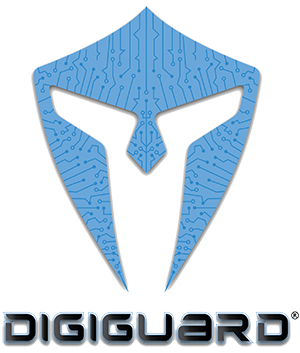Do You Need To Worry About Security For Blockchain?
Summary: This brief article explores the applications and risks of blockchain technology. If you have additional questions about blockchain or other cyber security solutions, contact DIGIGUARD CYBER SECURITY at 833-33-CYBER (833-332-9237) or visit www.DIGIGUARDsecurity.com to schedule a data security evaluation.
We are living in the age of digital data sharing. Sending and receiving large amounts of data globally has never been easier. But as they say, “With power comes responsibility.” Data stored and shared in the cyber world has forced businesses to upgrade their cyber security strategies.
Many businesses share specific data in a centralized system, allowing their vendors and partners to access the same information. However, most of the typical systems are fraught with vulnerabilities, opening businesses to ransomware attacks, identity theft and data breaches. Shared online data affords hackers many opportunities to commit cybercrimes. Fortunately, there is a new, secure technology for online transactional data sharing known as blockchain.
What Is Blockchain?
Blockchain technology is the platform that drives cryptocurrencies. However, its use has spread to many other platforms. Blockchain is an online, distributed ledger system or DLS that supports the secure posting and sharing of financial transactions. In a blockchain, different nodes work together to ensure each transaction is legitimate before being posted to the ledger. There are other great benefits afforded by blockchain technology:
- Superior Transparency – Because a blockchain ledger is decentralized, any authorized member of the network can check data recorded in the blockchain.
- Easily Traceable – Transactions posted to blockchain ledgers are easily traced back to their sources.
- Almost Hack-Proof – Some users ask, “Is block chain safe?” The answer is that it is very safe. Block chain encryption is top-notch, and it automatically timestamps every transaction.
- Immutability – Once a transaction is posted to a blockchain ledger, it cannot be edited or removed, which makes hacking or tampering more difficult.
- High Efficiency – Blockchain operations are fast and allow exceptional team collaboration. The increased efficiency yields monetary savings.
- Contract Automation – When particular criteria are met, some blockchain ledgers can execute smart contracts to automate selected transactions.
But Why Do They Call It “Blockchain?”
Blockchain ledgers have lists of transactions stored in blocks. Those blocks are linked using cryptographic hashes. Every block of records contains a cryptographic hash (a unique indentifier) linking it to the previous block. Also, the block will contain all transaction data and a timestamp making future verifications easy.
Risks Of Blockchain
As great an innovation as blockchain technology has proven to be, there are still some potential downsides to blockchain:
- No Standard Blockchain Framework – Because there is no standard for blockchain, different online ledger programs might not be compatible with each other.
- New Technology Difficult to Integrate – This relatively new technology without standardization does have some compatibility and integration problems.
- Increased User Responsibility – Without a centralized authority, users must be taught how to handle the blockchain accounts to which they have access. Users armed with private keys that are improperly stored can unwittingly allow access to their blockchain records.
- Speed of Transaction Completion – Although blockchain developers present transaction speed as a feature, the reality is that the speed varies. The cryptocurrency platform Bitcoin uses blockchain technology, and their transactions can sometimes take hours to complete.
- Insider Attacks by Malicious Users – Just as a company insider can launch a cyberattack, an authorized user can compromise a blockchain ledger.
- Lack of Scalability – Unfortunately, high user traffic on blockchain ledgers can significantly slow down the overall transaction rate.
- Uses Public and Private Key Encryption – Wikipedia (https://
en.wikipedia.org/ ) defines public key encryption or asymmetric encryption as “the field of cryptographic systems that use pairs of related keys. Each key pair consists of a public key and a corresponding private key. Key pairs are generated with cryptographic algorithms based on mathematical problems termed one-way functions.” These keys are comprised of a series of complex and difficult-to-guess characters. Private key encryption takes place at the user level and, therefore, must be stored securely. A hacker with access to a private key can attack the otherwise highly secure blockchain ledger. Without both keys, no access is permitted.wiki/ Public-key_cryptography - Hackers Attack Vulnerable User Devices – Cyberthieves are always searching for the weakest link through which to gain access. Unfortunately, they can capitalize on vulnerabilities in device cyber security, including improper password storage. One approach is to install malware on your device that can help capture your blockchain private key when you enter it. Much of device security is the responsibility of the user, who should take the following steps to protect a blockchain:
- Install Robust Antivirus Software and a Firewall
- Install All Updates for Your Devices
- Never Email Your Private Key To Anyone
- Do Not Store Your Keys In Any Text Documents on Your Devices
Blockchain technology is a very promising advancement in digital cyber security for financial records and transactions. Its decentralization, immutability and transparency offer significant upgrades to secure transactional functions. More and more companies are embracing blockchain projects. The increasing popularity will ultimately lead to additional security enhancements. As the cyber security target landscape continues to change and evolve, IT experts will find new ways to improve online data protection and patch the vulnerabilities related to blockchain technology.


